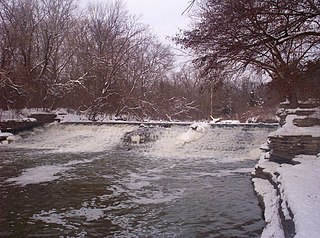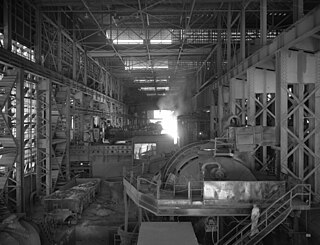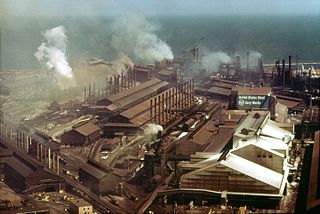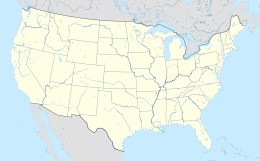
United States Steel Corporation, more commonly known as U.S. Steel, is an American integrated steel producer headquartered in Pittsburgh, Pennsylvania, with production operations primarily in the United States of America and in Central Europe. The company produces and sells steel products, including flat-rolled and tubular products for customers in industries across automotive, construction, consumer, electrical, industrial equipment, distribution, and energy. Operations also include iron ore and coke production facilities.

The River Rouge is a 127-mile river in the Metro Detroit area of southeastern Michigan. It flows into the Detroit River at Zug Island, which is the boundary between the cities of River Rouge and Detroit.

Downriver is the unofficial name for a collection of 19 cities and townships in Wayne County, Michigan, south of Detroit, along the western shore of the Detroit River.

The Ford River Rouge complex is a Ford Motor Company automobile factory complex located in Dearborn, Michigan, along the River Rouge, upstream from its confluence with the Detroit River at Zug Island. Construction began in 1917, and when it was completed in 1928, it was the largest integrated factory in the world, surpassing Buick City, built in 1904.

An ironworks or iron works is an industrial plant where iron is smelted and where heavy iron and steel products are made. The term is both singular and plural, i.e. the singular of ironworks is ironworks.
The Hum is a name often given to widespread reports of a persistent and invasive low-frequency humming, rumbling, or droning noise audible to many but not all people. Hums have been reported all over the world, including the United States, the United Kingdom, Australia and Canada. They are sometimes named according to the locality where the problem has been particularly publicized, such as the "Taos Hum" in New Mexico and the "Windsor Hum" in Ontario.
Wheeling-Pittsburgh Steel was a steel manufacturer based in Wheeling, West Virginia.

Geneva Steel was a steel mill located in Vineyard, Utah, United States, founded during World War II to enhance national steel output. It operated from December 1944 to November 2001. Its unique name came from a resort that once operated nearby on the shore of Utah Lake.

The Colorado Fuel and Iron Company (CF&I) was a large steel conglomerate founded by the merger of previous business interests in 1892. By 1903 it was mainly owned and controlled by John D. Rockefeller and Jay Gould's financial heirs. While it came to control many plants throughout the country, its main plant was a steel mill on the south side of Pueblo, Colorado, and was the city's main industry for most of its history. From 1901 to 1912, Colorado Fuel and Iron was one of the Dow Jones Industrials. The steel-market crash of 1982 led to the decline of the company. After going through several bankruptcies, the company was acquired by Oregon Steel Mills in 1993, and changed its name to Rocky Mountain Steel Mills. In January 2007, Rocky Mountain Steel Mills, along with the rest of Oregon Steel's holdings, were acquired by EVRAZ Group, a Russian steel corporation, for $2.3 billion.

Union Railroad is a Class III switching railroad located in Allegheny County in Western Pennsylvania. The company is owned by Transtar, Inc., which is a subsidiary of Fortress Transportation and Infrastructure Investors, after being acquired from U.S. Steel in 2021. The railroad's primary customers are the three plants of the USS Mon Valley Works, the USS Edgar Thomson Steel Works, the USS Irvin Works and the USS Clairton Works.

The Inland Steel Company was an American steel company active in 1893–1998. Its history as an independent firm thus spanned much of the 20th century. It was headquartered in Chicago at the landmark Inland Steel Building.

Kaiser Steel was a steel company and integrated steel mill near Fontana, California. Industrialist Henry J. Kaiser founded the company on December 1, 1941, and workers fired up the plant's first blast furnace, named "Bess No. 1" after Kaiser's wife, on December 30, 1942. Then in August 1943, the plant would produce its first steel plate for the Pacific Coast shipbuilding industry amid World War II.

SS Ste. Claire is a steamer located in Detroit, Michigan. Built in 1910, she was one of the last propeller-driven excursion steamers to be operated on the Great Lakes. She was declared a US National Historic Landmark in 1992. In 2018, a devastating fire destroyed the upper decks, leaving only the steel structure. The ship was delisted as a National Historic Landmark and from the National Register of Historic Places in 2023.
The Duluth Works was an industrial steel and cement manufacturing complex located in Duluth, Minnesota, United States, in operation 1915 to 1987. The complex was operated by the United States Steel Corporation. Officially, the plant's purpose was to supply the growing Midwest with steel finished products. Unofficially, they were built as part of a "gentleman's agreement" between U.S. Steel and the State of Minnesota to not impose hefty iron ore taxes on U.S. Steel in exchange for a fully integrated steel plant within Minnesota, whose mines furnished 80% of the ore to U.S. Steel. The combined works of the steel and cement plant were the largest employers in Duluth and the fourth largest industrial complex in Minnesota.
The HIsarna ironmaking process is a direct reduced iron process for iron making in which iron ore is processed almost directly into liquid iron (pig iron). The process combines two process units, the Cyclone Converter Furnace (CCF) for ore melting and pre-reduction and a Smelting Reduction Vessel (SRV) where the final reduction stage to liquid iron takes place. The process does not require the manufacturing of iron ore agglomerates such as pellets and sinter, nor the production of coke, which are necessary for the blast furnace process. Without these steps, the HIsarna process is more energy-efficient and has a lower carbon footprint than traditional ironmaking processes. In 2018 Tata Steel announced it has demonstrated that more than 50% CO2 emission reduction is possible with HIsarna technology, without the need for carbon capture technology.
This steelmaking plant was originally part of the Ford Motor Company, which created an integrated manufacturing complex to produce all major vehicle components at one large facility called The Rouge. In 1989, Ford's steel mill assets were divested and became known as Rouge Industries with the steel operations trading as Rouge Steel Company in Dearborn, Michigan, outside of Detroit.

The Gary Works is a major steel mill in Gary, Indiana, on the shore of Lake Michigan. For many years, the Gary Works was the world's largest steel mill, and it remains the largest integrated mill in North America. It is operated by U.S. Steel.
In 2022, the United States was the world’s third-largest producer of raw steel, and the sixth-largest producer of pig iron. The industry produced 29 million metric tons of pig iron and 88 million tons of steel. Most iron and steel in the United States is now made from iron and steel scrap, rather than iron ore. The United States is also a major importer of iron and steel, as well as iron and steel products.

The US iron and steel industry has paralleled the industry in other countries in technological developments. In the 1800s, the US switched from charcoal to coal in ore smelting, adopted the Bessemer process, and saw the rise of very large integrated steel mills. In the 20th century, the US industry successively adopted the open hearth furnace, then the basic oxygen steelmaking process. Since the American industry peaked in the 1940s and 1950s, the US industry has shifted to small mini-mills and specialty mills, using iron and steel scrap as feedstock, rather than iron ore.



















